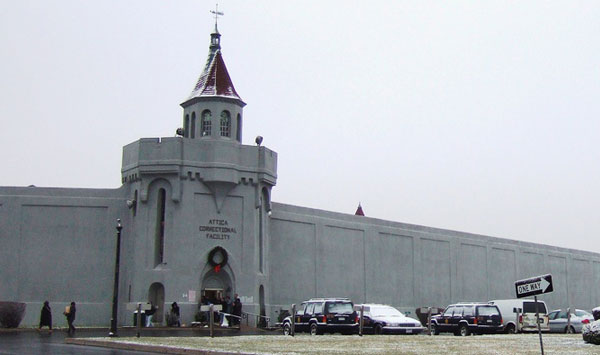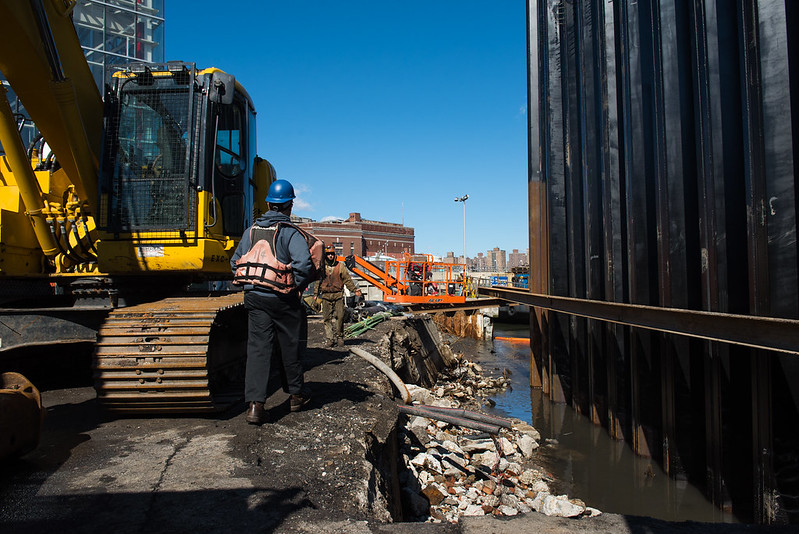In Presidential Campaign, Progressive Democrats’ Death Penalty Stances Fall Short

Attica (photo: Wikimedia Commons)
Democrats Bernie Sanders and Elizabeth Warren are widely known as the most liberal lawmakers vying to be the party’s presidential nominee in 2020. Both believe in healthcare, higher education, and childcare for all. They often cite that the country lags behind most other countries of the world in areas of maternity health, infant mortality, economic and wealth inequality, and many other societal measures of health and well-being. However, as far as international standards go, Warren and Sanders are both out of touch in their belief in permanent punishment and life imprisonment in the U.S. criminal justice system.
In June 2019, the New York Times interviewed Sanders, Warren, and the slew of other Democratic presidential candidates running at the time about their stances across many foreign policy and domestic issues, including the death penalty. Just about all of the candidates interviewed affirmed that they opposed the death penalty. Warren and Sanders took their stances a step further, adding that they believed people should be locked up forever as an alternative to the death penalty.
“I also oppose [the death penalty] because I think that people who have committed truly heinous crimes should die in prison, suffering for the rest of their lives,” emphasized Warren. Sanders echoed Warren in his reply by saying, “You have people who should spend the rest of their lives behind bars…” Sanders continued his anti-death penalty stance by saying, “part of the need for real criminal justice reform is for the United States to do what virtually every other major country on earth is doing.”
If Sanders and Warren want to continue to separate themselves from the Democratic presidential pack, then they should look to do what just about every major country on earth is doing and begin to unravel, not reinforce, life imprisonment. They should also examine the historical reality that the people condemned to a life of suffering and death by incarceration in the United States are disproportionately People of Color.
While it’s common knowledge that the United States has roughly 5 percent of the world’s population and 25 percent of the world’s incarcerated, fewer people know that 40 percent of all people on the planet serving a life sentence are behind bars in the U.S. Today, there are more than 206,000 people serving a life sentence in U.S. state and federal prisons—more than the total number of people in all U.S. prisons in 1972. Unsurprisingly, the large majority are black and Latino people. I was one of them.
In 1980, I was convicted of bank robbery and attempted murder of a New York City police sergeant. For the next 38 years, I served a life sentence and met countless others who were also sanctioned to life and death behind bars. I saw firsthand how life imprisonment ripped hope from people’s souls, permanently separated families, and destabilized entire communities, particularly communities of color. I witnessed my fellow lifers take their last breaths in prison cells and hospice beds, grow confused with dementia about why they were in prison in the first place, and age years and decades faster than most people in the outside world.
In January 2018, I was finally released from prison. The day I walked out of prison was the happiest day of my life. It was a day I started to suspect would never come for me.
Over the years some of my closest friends, men who were my mentors, others I had mentored, passed away behind bars. We shared decades of our lives helping each other confront the thinking that led to our incarceration and developing and facilitating the most comprehensive in-prison therapeutic programs that helped to completely change our behavior. We created victim awareness workshops and seminars to develop insight into the harm our crimes inflicted on innocent people. We took full responsibility for rehabilitating ourselves and empowering others with life-affirming principles and values, and a sense of community.
As my brother drove me past the prison grounds I thought about the men I was leaving behind, men who should have been walking out of the prison gates with me. Instead, many will likely die in prison.
When U.S. elected leaders talk about who should suffer and die in prison, they’re talking about men I personally know, men and women who for decades have helped entire generations of younger people transform their lives and who often pose no risk to public safety. Instead, they would enhance the safety of communities if given the chance to return home.
Formerly incarcerated people are often the only ones willing and able to reach out to at-risk young adults who are otherwise abandoned and neglected by society. We give them a vision of a future that does not include gangs, violence, and crime. Such men and women are the reason why I am the man I am today. They are the reason why formerly incarcerated people today serve as credible messengers, violence interrupters, and street counselors. They have helped their peers develop a greater sense of community and civic responsibility than most people who have never been incarcerated.
For these reasons and more, there is a growing national movement working against the sentiments expressed by Sanders and Warren. A movement founded on the fundamental principle that every incarcerated person has the potential for genuine transformation. Death by incarceration sentences are inhumane and rooted in the legacy of racism. They also don’t make us safer.
Decades of research has proven that life imprisonment does not promote public safety, deter crime, or meet the many needs of victims and survivors of interpersonal violence. Further, those serving life sentences are least likely to commit another crime or return to prison upon release as they grow old behind bars. This is even true for people convicted of murder and other forms of serious violence.
The rest of the world realizes these truths, and lawmakers in some states have started to realize them too. In New York for instance, lawmakers are working to pass a bill that would allow the State Board of Parole to give individualized case reviews and assessments for release to people in prison who are age 55 and older and have served 15 or more years. The governor of Virginia recently proposed a similar elder parole policy, while legislators in Pennsylvania, Massachusetts, and Washington State have proposed an end to life without parole sentences.
While there is no one clear way to end prison sentences that amount to permanently punishing people and families, there is a growing understanding that something must be done. Warren, Sanders, and the other Democrats seeking to pave a progressive path to being the next Democratic nominee for president should get on board.
***
Jose Saldana is the Director of the Release Aging People in Prison Campaign, a community organizing and advocacy campaign that works to reform long and life prison sentences and promote racial justice. On Twitter @RAPPcampaign.
***
Have an op-ed idea or submission for Gotham Gazette? Email This email address is being protected from spambots. You need JavaScript enabled to view it.
Empowering Communities to Investigate Potentially Toxic Development

(photo: Edwin J. Torres/Mayoral Photo Office)
Without the network of parents that I have met at my daughter’s school in the historic South Street Seaport, I might never have heard about a real estate developer’s purchase of a parking lot directly across the street that was once the site of the largest thermometer factory complex in the country.
This parking lot is located at 250 Water Street and sits adjacent to the entrances of PS 343 Peck Slip and the Blue School, which is another school that serves pre-kindergarten through fifth-grade children.
I wouldn’t have given the lot a second thought, until a parent told me that the developer – the Howard Hughes Corporation – applied the site to the New York State Department of Environmental Conservation’s Brownfield Cleanup Program.
The words “Brownfield Cleanup” immediately brought to mind nuclear waste sites and decommissioned oil fields, making me question for the first time what was actually under that parking lot.
Alongside other parents and community members, our research uncovered a startling fact: the parking lot at 250 Water Street was the location of several thermometer factories. At one point, this was the largest thermometer factory complex in the entire country. Factories that allowed harmful mercury to seep into the topsoil due to lax regulations when they were in operation. Right now, the parking lot “caps” the mercury, protecting the community from harm, we have been told by state officials. Without this cap, toxic chemicals would be released into the community.
Developers favor the Brownfield Cleanup Program because it releases them from liability if contamination spreads to neighboring sites – in this case like my daughter’s school. If such contamination occurs with a brownfield site, the state assumes liability. And of course, the developer also receives considerable tax credits for using a BCP site. Given past stories of government remediation of toxic sites, this all gives us no comfort.
Understanding that environmental remediation is too expensive for the city or state to do on its own, it’s up to private developers to fund the cleanup. This includes private developers having to pay for their own environmental engineering firm to provide site analysis to include in their application for NYSDEC’s consideration.
I have no doubt that developers would like to prevent young children from getting sick. But I also know that as profit-maximizing entities, their incentives are not necessarily aligned to take the measures needed to protect a community if it costs them more time and money in the short-run.
The NYSDEC does provide a Technical Assistance Grant (TAG) of $50,000 for communities to do their own research – money that could be used to hire an environmental engineer or a lawyer to represent the community – but a TAG can only be applied for once the scope of remediation is already determined, giving the community no power to protect itself. Also, a TAG must be deemed necessary by both the NYSDEC and the private corporation (a law that must be amended).
In our own community fight, as the current assemblywoman was unable to do so, I worked with the Manhattan Borough President’s office to help secure $50,000 of funding from the private real estate developer at 250 Water Street. The funding has been used to hire a physical geologist as an independent community monitor, who has already fundamentally altered the course of the development. Most communities aren’t as lucky to be able to obtain this type of support but deserve the right to be protected.
Our state government in Albany should amend New York State’s Environmental Conservation Law to allow communities to apply for the Technical Assistance Grant as soon as a project is approved to the Brownfield Cleanup Program – not after the Remedial Investigation Work Plan (RIWP) is concluded. Lawmakers can close this ‘developers first, communities last’ provision by amending Article 27, Title 14, Section 27-1417 of the Environmental Conservation Law.
In New York City alone, there are over 200 brownfield cleanup sites currently active. Where are these sites predominantly located? In working class communities like Chinatown, the Lower East Side, Morningside Heights, and East New York. Amending Environmental Conservation Law in this manner would be a clear victory for environmental justice.
No one should tolerate their children or neighbors being exposed to life-threatening toxins, and we deserve elected officials who will fight to protect their constituents, not sell them out to corporations.
***
Grace Lee is the founder of Children First, a parent-led activist group fighting for the safe cleanup of a toxic site located in the South Street Seaport. She is a candidate for the New York State Assembly, 65th district. On Twitter @graceleefornyc.
***
Have an op-ed idea or submission for Gotham Gazette? Email This email address is being protected from spambots. You need JavaScript enabled to view it.
Cuomo’s Cannabis Bill Locks Out Farmers and Preserves Illegal Market in New York

(photo: @nysmallfarma)
As a state government ends the prohibition of cannabis, it can choose to regulate so as to create an industry that favors industrially produced cannabis from large national players and/or it can choose to create a small-scale local cannabis industry. As we’ve now witnessed in Canada, the industrial cannabis industry sacrifices quality for quantity, producing mediocre expensive cannabis, grown at great threat to our planet due to the massive amount of greenhouse gas emissions from indoor cultivation. And as Canada’s example shows, the illegal market will thus continue to flourish.
The only way New York will end the illegal market is if it creates a competitive product. Artisanal craft cannabis, grown under the sun by farmers who know how to produce regenerative high-quality cannabis without synthetic chemicals, is that product. And yet Governor Cuomo’s new bill to legalize adult-use cannabis effectively excludes farmers from growing cannabis.
We at NY Small FarmA, representing the interests of small farmers and those who wish to purchase the healthy, artisanal strains regenerative farmers can produce, were hoping the governor might lead the way in creating this small cultivation and manufacturing industry as he so proudly did for craft breweries.
“New York's craft beverage industry is booming...we have seen significant growth in the number of manufacturers supporting our local farms and spurring job creation across the Empire State,” Cuomo announced in 2018, having just prior proclaimed a record number of breweries in the state he said were “creating jobs, driving tourism, helping our local farms, and instilling pride in every corner of this great state.”
But the bill the governor recently put out as part of his 2020 agenda not only fails to support a craft farm cannabis industry, it makes it impossible for farmers to grow in New York! By failing to recognize cannabis as an agricultural crop and failing to provide the same support the governor provided when recognizing cannabis hemp as an agricultural crop, the governor’s bill will result in the exclusion of farmers from this new industry. This is true because he is not proposing a change to the agriculture and markets law.
The governor knows how to support an agricultural crop when he wants to. He just announced up to $10 million in funding to advance hemp research and economic development opportunities for hemp businesses. When cannabis hemp was legalized in New York, it was expressly recognized as an agricultural crop. Hemp is also the exact same cannabis plant as the plant we all know as marijuana. The only difference between the two is the amount of THC (Tetrahydrocannabinol).
Rather than support what could be a huge revitalization of farming communities, the governor’s bill is a gift to large out-of-state businesses. Adding insult to injury, this bill will fail to produce the tax revenues the governor is counting on because his plan will only fuel the existing illegal cannabis market in New York.
There is still time to urge the governor to amend his bill, incorporating the statutory provisions laid out in NY Small FarmA’s platform. If this bill passes without these provisions, New Yorkers’ only options will be to spend more for inferior quality, pesticide-laden cannabis or continue to find less expensive, higher quality cannabis illegally. There will be no option to purchase healthy, pure regeneratively grown, pesticide-free cannabis, unless you know a farmer you trust and are willing to risk the criminal consequences. This is not how prohibition should end.
***
Andi Novick, Esq., is founder and president of New York Small Farm Alliance of Cannabis Growers & Supporters (NY Small FarmA). On Twitter @nysmallfarma.
***
Have an op-ed idea or submission for Gotham Gazette? Email This email address is being protected from spambots. You need JavaScript enabled to view it.




